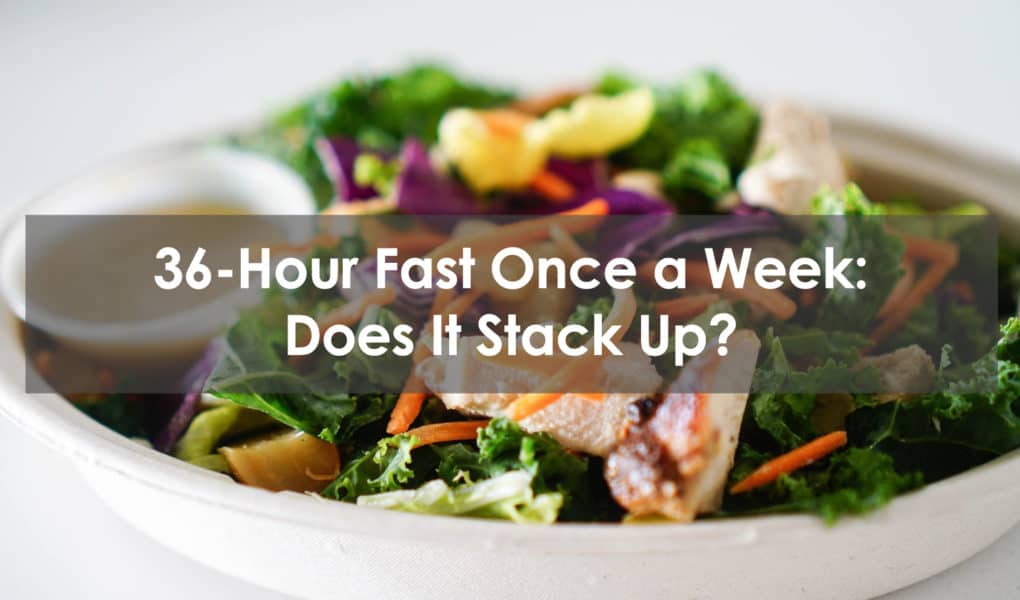When it comes to losing weight, there are many paths you can follow. One of the easiest to implement is the 36-hour fast once a week. Also known as Monk Fasting, the 36-hour fast simply involves taking a day off from eating every week.
Many people have had great success with this approach, while others say that it is too extreme.
In this article, we delve into the 36-hour diet to see whether it stacks up.
What is the 36-Hour Fast?

A 36-hour fast is a form of intermittent fasting that involves fasting for 36 hours out of every 168-hour week. The diet was created by the guys at WeFast, an online dieting community. The WeFast crowd labels it the Monk Fasting Diet.
Typically, 36-hour fasting started after dinner one evening and runs all through the following day and night until the morning of the third day. Here’s an example …
You finish eating at 7 pm on Sunday. Your fast runs for an extended period all the way through until Wednesday at 7 am.
36-Hour Fast Health Benefits
The beneficial effects of fasting go beyond body composition. Here are six ways the 36-hour fast can benefit you.
Promotes Ketosis
The 36-hour fast will cause the vast majority of people to go into a state of ketosis. You enter ketosis when your body has used up all of its glycogen stores and must rely on stored body fat to supply its energy needs.
It takes between 12 and 36 hours for people to enter ketosis, depending on how many carbohydrates you’ve consumed just prior to the fast and your own metabolism.
Fat Loss

While there are no specific studies on the fat loss benefits of the 36 hours fast, there is plenty of research to show that fasting can significantly boost weight loss, including losing belly fat. A full day of fasting on a regular basis has been shown to help lose as much as 9 percent of a person’s body weight.
When you fast for 36 hours, you will also significantly decrease your calorie intake over the week. That will help you to maintain a caloric deficit, where your body is using up more energy calories than it takes in. This will force the body to turn to stored body fat to make up the difference.
Fasting may also increase the basal metabolic rate, reduce oxidative stress, and improve blood sugar management.
Anabolic Hormones
Pairing intermittent fasting with weight resistance training has also been shown to increase fat loss and muscle gain. Fasting has been shown to increase the body’s production of such anabolic hormones as testosterone and human growth hormone.
Increased Longevity
Research with animals has shown that fasting may help to offset the natural aging process and help you live longer. Researchers believe this is due to the increase in the process of autophagy. This is the process by which the body removes dead cells and regenerates healthy ones.
Intermittent fasting is also believed to help to offset the symptoms of such conditions as Parkinson’s disease, heart disease, diabetes, and even cancer. More studies with humans are needed, though, to verify these effects.
Heart Health Benefits

Animal studies have shown that fasting may lower blood pressure levels. It has also been shown to decrease the level of bad LDL cholesterol while increasing good HDH cholesterol levels.
Blood Sugar Control
Intermittent fasting research indicates that fasting leads to improvements in blood sugar. Several studies have shown that fasting reduces blood sugar levels and increases insulin sensitivity. This makes it easier for the body to transport sugar into the muscle cells.
36-Hour Fast Negatives
Hard to Maintain
Fasting for 36 hours can be challenging for some people. As a result, they might find it difficult to maintain their diet. Shorter non-food period fasting diets like the 12-hour fast, 14 to 18-hour fast, or 24-hour fasts will be easier to follow.
May Cause Mild Side Effects
Some people may also experience such side effects as dizziness, headache, and fatigue when they fast for 36 hours. This is usually temporary, though, and can often be eliminated by drinking more water.
May Interfere with Social Life
If you are planning to meet friends for dinner, you don’t really want your diety to get in the way. However, if you’re in the middle of a 36-hour diet, you’ve got a problem. As a result, you should plan to do your fast mid-week when you are less likely to have evening social engagements.
How to Do the 36-Hour Diet
The first step to implementing the 36-hour diet is to decide what days you will do it. The creators of the Monk diet, recommend starting at 7 on Monday and going through until 7 am on Wednesday. That’s because there are less likely to be social engagements on those days.
Even though 36 hours sounds like a long time, a number of those hours will be consumed by sleep. Be sure to drink plenty of water throughout the fast. You can also consume non-caloric beverages. One of my favorites is bone broth, which provides protein and tastes like a hearty soup mixture.
Tea and non-calorie sugar-free coffee can also be consumed during the fast.
At the end of the fast, ease back into eating with a light meal. If you have a heavy meal, you will feel bloated and probably have gas and diarrhea.
Summary
The 36-hour diet is a variation of intermittent fasting that involves fasting for 36 hours every 7 days. It usually runs from 7 pm one day, all through the next day, and until 7 on the third day.
This episodic fasting diet will help you to get into ketosis so you can burn stored body fat for energy. There are also numerous benefits beyond weight loss. Drink plenty of water through the diet and ease back into eating gradually to avoid negative consequences.
Frequently Asked Questions
What is the Monk Fast?
The monk fast is another name for the 36-hour once-a-week fast. It was invented and named by the online dieting community at WeFast. This is one of several variations of intermittent fasting.
How do you do the 36-hour fast?
To do the 36-hour fast you should choose a day of the week to start the fast and then stop eating at 7 pm on that day. Continue fasting through that night, all through the next day, and night until 7 am on the third morning. at that point, you should start gradually reintroducing food.
What should I eat during the non-fasting part of the week?
During the non-fasting part of the week, you should follow a healthy, balanced diet. This should include plenty of lean proteins, healthy fats, and complex carbs. Stay away from processed foods, high glycemic carbs, and saturated fats.







